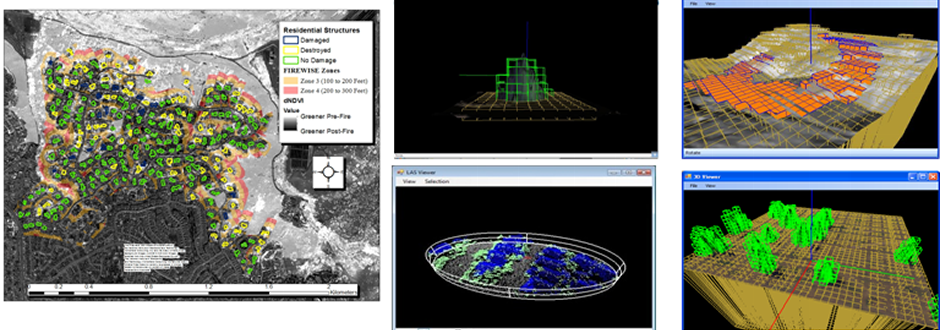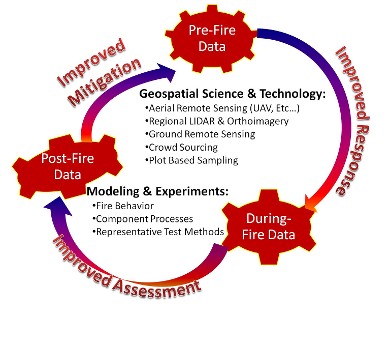
Geospatial Measurement Solutions, LLC: Custom software development; database maintenance and development; remote sensing analysis, data collection, mobile technology implementation, and scientific analysis and documentation.

Wildland-Urban Interface (WUI) and Wildland Fire Data Collection (National Institute of Standards and Technology Fire Research Grant 60NANB11D173)
Data collection for the WUI and Wildland fire problems span numerous disciplines and professions and should be an iterative process as shown in Figure 1 to produce improved response to fires, improved assessment of fires and ultimately provide improved mitigation solutions. Data collected from real world fire incidents requires the application of geospatial science and technology to feed intelligent and useful information for model and experiment development. Listed below are various key sources of information historically used to gain an understanding of the WUI and Wildland Fire problems:
Exploitation of the above data collection sources for understanding the WUI and wildland fire problems are in there infancy. There are limited tools and techniques to assess the quality and quantity of expert opinions on the WUI and wildland fire problems. For example, in a recent study of the 2012 Waldo Canyon Fire over 4500 person-hours were spent on technical discussions with first responders to obtain basic information on defensive actions and damaged structures. More efficient methods to obtain information from expert witnesses on WUI and wildland fires are required as recognized by industry experts (Metcalf, 2015). Documentation of the above described spatiotemporal data is typically limited with formal geospatial metadata detailing specifics of the data product rarely being produced. Private citizens applying citizen science is also underutilized in the WUI with some exceptions (e.g. Ferster et al., 2013). For example, wind patterns through WUI communities are poorly understood. Recent studies of the Trails at Rancho Bernardo Community have attempted to model wind in this community but due to logistical constraints could only install 17 anemometers. The locations of these anemometers were driven by the locations of public utility poles and not necessarily optimum placement of sensors for measuring wind across a community. Private weather stations operated by homeowners could be utilized if placed correctly to more ubiquitously sample wind and weather in WUI communities. Finally, government data collection, experiments and post-fire assessments suffer from a lack of scientific archival of data collected, lack of collaboration and integration and coordination between scientists (National Science Technology Council, 2015) and multidisciplinary approaches compared to the required interdisciplinary approaches.
|
©2013 Geospatial Measurement Solutions, LLC - 2149 Cascade Ave. Ste. 106A PMB 240 Hood River, OR 97031, USA 541-436-4486 dmgeo@gmsgis.com
